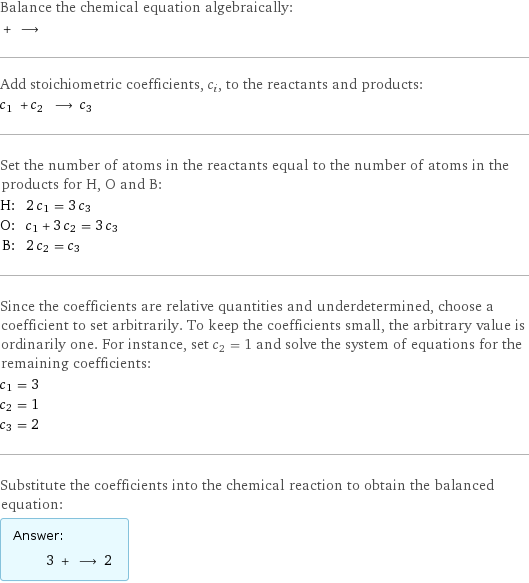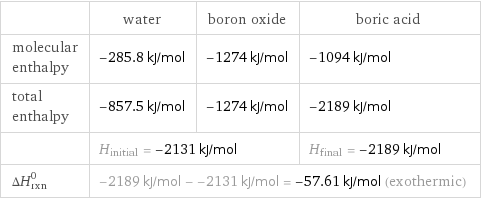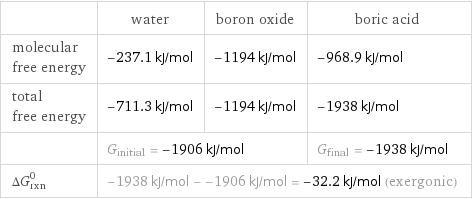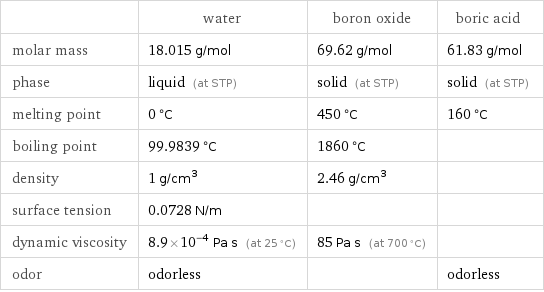Input interpretation

water + boron oxide ⟶ boric acid
Balanced equation

Balance the chemical equation algebraically: + ⟶ Add stoichiometric coefficients, c_i, to the reactants and products: c_1 + c_2 ⟶ c_3 Set the number of atoms in the reactants equal to the number of atoms in the products for H, O and B: H: | 2 c_1 = 3 c_3 O: | c_1 + 3 c_2 = 3 c_3 B: | 2 c_2 = c_3 Since the coefficients are relative quantities and underdetermined, choose a coefficient to set arbitrarily. To keep the coefficients small, the arbitrary value is ordinarily one. For instance, set c_2 = 1 and solve the system of equations for the remaining coefficients: c_1 = 3 c_2 = 1 c_3 = 2 Substitute the coefficients into the chemical reaction to obtain the balanced equation: Answer: | | 3 + ⟶ 2
Structures

+ ⟶
Names

water + boron oxide ⟶ boric acid
Reaction thermodynamics
Enthalpy

| water | boron oxide | boric acid molecular enthalpy | -285.8 kJ/mol | -1274 kJ/mol | -1094 kJ/mol total enthalpy | -857.5 kJ/mol | -1274 kJ/mol | -2189 kJ/mol | H_initial = -2131 kJ/mol | | H_final = -2189 kJ/mol ΔH_rxn^0 | -2189 kJ/mol - -2131 kJ/mol = -57.61 kJ/mol (exothermic) | |
Gibbs free energy

| water | boron oxide | boric acid molecular free energy | -237.1 kJ/mol | -1194 kJ/mol | -968.9 kJ/mol total free energy | -711.3 kJ/mol | -1194 kJ/mol | -1938 kJ/mol | G_initial = -1906 kJ/mol | | G_final = -1938 kJ/mol ΔG_rxn^0 | -1938 kJ/mol - -1906 kJ/mol = -32.2 kJ/mol (exergonic) | |
Chemical names and formulas

| water | boron oxide | boric acid Hill formula | H_2O | B_2O_3 | BH_3O_3 name | water | boron oxide | boric acid
Substance properties

| water | boron oxide | boric acid molar mass | 18.015 g/mol | 69.62 g/mol | 61.83 g/mol phase | liquid (at STP) | solid (at STP) | solid (at STP) melting point | 0 °C | 450 °C | 160 °C boiling point | 99.9839 °C | 1860 °C | density | 1 g/cm^3 | 2.46 g/cm^3 | surface tension | 0.0728 N/m | | dynamic viscosity | 8.9×10^-4 Pa s (at 25 °C) | 85 Pa s (at 700 °C) | odor | odorless | | odorless
Units
